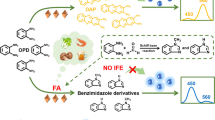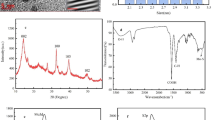Abstract
A new fluorescence strategy was described for ratiometric sensing of formaldehyde (FA) with bifunctional MOF, which acted as a fluorescence reporter as well as biomimetic peroxidase. With the assistance of H2O2, NH2-MIL-101 (Fe) catalyzes the oxidation of non-luminescent substrate o-phenylenediamine (OPD) to produce fluorescent product (oxOPD) with the maximum emission at 570 nm. Besides, intrinsic fluorescence of MOF (λem = 445 nm) was quenched by oxOPD through inner filter effect (IFE). However, FA and OPD reacted to generate Schiff bases, which competitively consumed OPD inhibiting the generation of oxOPD. Under the excitation wavelength of 375 nm, a ratiometric strategy was designed to detect FA with the fluorescence intensity ratio at 445 nm and 570 nm (F445/F570) as readout signal. This strategy exhibited a wide linear range (0.1–50 μM) and low detection limit of 0.03 μM. This method was confirmed for FA detection in food samples. In addition to establishing a new method to detect FA, this work will open new applications of MOF in food safety.
Graphical Abstract







Similar content being viewed by others
Data availability
All data generated or analyzed during this study are included in this article and its supplementary information files.
References
Ding H, Yuan G, Peng L, Zhou L, Lin Q (2020) TP-FRET-based fluorescent sensor for ratiometric detection of formaldehyde in real food samples, living cells, tissues, and zebrafish. J Agric Food Chem 68:3670–3677
Zhao Q, Shen T, Liu Y, Hu X, Zhao W, Ma Z, Li P, Zhu X, Zhang Y, Liu M, Yao S (2021) Universal nanoplatform for formaldehyde detection based on the oxidase-mimicking activity of MnO2 nanosheets and the in situ catalysis-produced fluorescence species. J Agic Food Chem 69:7303–7312
Liu C, Shi C, Li H, Du W, Li Z, Wei L, Yu M (2015) Nanomolar fluorescent quantitative detection of formaldehyde with a 8-hydroxyquinoline derivative in aqueous solution and electrospun nanofibers. Sensor Actuat B: Chem 219:185–191
Yuan G, Ding H, Peng L, Zhou L, Lin Q (2020) A novel fluorescent probe for ratiometric detection of formaldehyde in real food samples, living tissues and zebrafish. Food Chem 331:127221
Bi A, Gao T, Cao X, Dong J, Liu M, Ding N, Liao W, Zeng W (2018) A novel naphthalimide-based probe for ultrafast, highly selective and sensitive detection of formaldehyde. Sensor Actuat B: Chem 255:3292–3297
Zhang D, Zhang J, Li M, Aimaiti G, Tuersun G, Ye J, Chu Q (2011) A novel miniaturised electrophoretic method for determining formaldehyde and acetaldehyde in food using 2-thiobarbituric acid derivatization. Food Chem 129:206–212
Cui X, Fang G, Jiang L, Wang S (2007) Kinetic spectrophometric method for rapid determination of trace formaldehyde in foods. Anal Chim Acta 590:253–259
Nie X, Chen Z, Tian Y, Chen S, Qu L, Fan M (2021) Rapid detection of trace formaldehyde in food based on surface-enhanced Raman scattering coupled with assembled purge trap. Food Chem 340:127930
Zhao X, Zhang Z (2009) Microwave-assisted on-line derivatization for sensitive flow injection fluorometric determination of formaldehyde in some foods. Talanta 80:242–245
Cao Y, Teng Z, Zhang J, Cao T, Qian J, Wang J, Qin W, Guo H (2020) A fluorescent probe for distinguish detection of formaldehyde and acetaldehyde. Sensor Actuat B: Chem 320:128354
Qu F, Guo Z, Jiang D, Zhao XE (2021) In situ growth of polydopamine on surface of covalent organic frameworks under the catalysis of acid phosphatase for dopamine detection. Chin Chem Lett 32:3368–3371
He L, Yang X, Ren M, Kong X, Liu Y, Lin W (2016) An ultra-fast illuminating fluorescent probe for monitoring formaldehyde in living cells, shiitake mushrooms, and indoors. Chem Commun 52:9582
Zhou W, Dong H, Yan H, Shi C, Yu M, Wei L, Li Z (2015) HCHO-reactive molecule with dual-emission-enhancement property for quantitatively detection HCHO in near 100% water solution. Sensor Actuat B: Chem 209:664–669
Jana A, Baruah M, MunanSamanta S (2021) A ICT based water-soluble fluorescent probe for discriminating mono and dicarbonyl species and analysis in foods. Chem Commun 57:6380
Zhang Y, Qi J, Li M, Gao D, Xing C (2021) Fluorescence probe based on graphene quantum dots for selective, sensitive and visualized detection formaldehyde in food. Sustainability 13:5273
Akshath U, Bhatt P (2018) Supramolecular nano-sniffers for ultrasensitive detection of formaldehyde. Biosens Bioelectron 100:201–207
Akshath U, Bhatt P (2016) Tunneling of redox enzymes to design nano-probes for monitoring NAD+ dependent bio-catalytic activity. Biosens Bioelectron 85:240–246
Xia M, Zhao XE, Sun J, Zheng ZJ, Zhu SY (2020) Graphene quantum dots combined with the oxidase-mimicking activity of Ce4+ for ratiometric fluorescent detection of Ce4+ and alendronate sodium. Sensor Actuat B: Chem 319:128321
Liu LY, Zhu SY, Sun J, Xia M, Zhao XE, Xu GB (2021) Ratiometric fluorescence detection of bleomycin based on proximity-dependent fluorescence conversion of DNA-templated silver nanoclusters. Chin Chem Lett 32:906–909
Shi L, Li N, Wang D, Fan M, Zhang S, Gong Z (2021) Environmental pollution analysis based on the luminescent metal organic frameworks: a review. Trend Anal Chem 134:116131
Karthik P, Pandikumar A, Preeyanghaa M, Kowsalya M, Neppolian B (2017) Amino-functionalized MIL-101(Fe) metal organic framework as a viable fluorescent probe for nitroaromatic compounds. Microchim Acta 184:2265–2273
Liu P, Li X, Xu X, Ye K, Wang L, Zhu H, Wang M, Niu X (2021) Integrating peroxidase-mimicking activity with photoluminescence into one framework structure for high-performance ratiometric fluorescent pesticide sensing. Sensor Actuat B: Chem 328:129024
Li S, Hu X, Chen Q, Zhang X, Chai H, Huang Y (2019) Introducing bifunctional metal-organic frameworks to the construction of a novel ratiometric fluorescence sensor for screening acid phosphatase activity. Biosen Bioelestron 137:133–139
Xia YH, Sun KM, Zuo YN, Zhu SY, Zhao XE (2022) Fluorescent MOF-based nanozymes for discrimination of phenylenediamine isomers and ratiometric sensing of o-phenylenediamine. Chin Chem Lett 33:2081–2085
Wang LJ, Wen LJ, Zheng SJ, Tao FF, Chao J, Wang F, Li CL (2022) Integrating peroxidase-mimicking NH2-MIL-101 (Fe) with molecular imprinting for high-performance ratiometric fluorescence sensing of domoic acid. Sensor Actuat B: Chem 361:131688
Zhao XE, Zuo YN, Xia YH, Sun J, Zhu SY, Xu GB (2022) Multifunctional NH2-Cu-MOF based ratiometric fluorescence assay for discriminating catechol from its isomers. Sensor Actuat B: Chem 371:132548
Deng L, Liu Q, Lei C, Zhang Y, Huang Y, Nie Z, Yao S (2020) Fluorometric and colorimetric dual-readout assay for histone demethylase activity based on formaldehyde inhibition of Ag+-triggered oxidation of o-phenylenediamine. Anal Chem 92:9421–9428
Shen J, Wu J, Sun X, Wu Z, Gao P, Liu B (2017) Formaldehyde sensing based on the catalytic reaction of β-HgS nanocrystals. J Mater Chem 5:3757
Ahamd I, Zhou Z, Li H, Zang S (2020) Crafting CdTe/CdS QDs surface for the selective recognition of formaldehyde gas via ratiometric contrivance. Sensor Actuat B: Chem 304:127379
Liu H, Sun Y, Li Z, Yang J, Aryee A, Qu L, Du D, Lin Y (2019) Lysosome-targeted carbon dots for ratiometric imaging of formaldehyde in living cells. Nanoscale 11:8458
Li C, Hung J, Zhu H, Liu L, Feng Y, Hu G, Yu X (2017) Dual-emitting fluorescence of Eu/Zr-MOF for ratiometric sensing formaldehyde. Sensor Actuat B: Chem 253:275–282
Wang XL, Reham A, Kong RM, Cheng YY, Tian XX, Liang MS, Zhang LD, Xia L, Qu FL (2021) Naphthalimide derivative-functionalized metal-organic framework for highly sensitive and selective determination of aldehyde by space confinement-induced sensitivity enhancement effect. Anal Chem 93:8219–8227
Xu X, Su R, Zhao X, Liu Z, Li D, Li XY, Zhang HQ, Wang ZM (2011) Determination of formaldehyde in beverages using microwave-assisted derivatization and ionic liquid-based dispersive liquid-liquid microextraction followed by high-performance liquid chromatography. Talanta 85:2632–2638
Li P, Zhang D, Zhang Y, Lu W, Wang W, Chen T (2018) Ultrafast and efficient detection of formaldehyde in aqueous solutions using chitosan-based fluorescent polymers. ACS Sens 3:2394–2401
Zou G, Guo L, Chen S, Liu N, Yu Y (2022) Multifunctional ratiometric fluorescent sensing platform constructed by grafting various response groups on carbon dots with bromine active site for biosensing and bioimaging. Sensor Actuat B: Chem 357:131376
Ding H, Yuan G, Peng L, Zhou L, Lin Q (2020) TP-FRET-based fluorescent sensor for ratiometric detection of formaldehyde in real samples, living cells, tissues, and zebrafish. J Agric Food Chem 68:3670–4367
Acknowledgements
This work was financially supported by the National Natural Science Foundation of China (Nos. 22076097, 22176109 and 22174100), the Natural Science Foundation of Shandong Province (No. ZR2020MB066), and the Qinghai Special Project of Innovation Platform for Basic Conditions of Scientific Research of China (No. 2022-ZJ-Y18).
Author information
Authors and Affiliations
Corresponding authors
Ethics declarations
Competing interests
The authors declare no competing interests.
Additional information
Publisher's note
Springer Nature remains neutral with regard to jurisdictional claims in published maps and institutional affiliations.
Supplementary Information
Below is the link to the electronic supplementary material.
Rights and permissions
Springer Nature or its licensor (e.g. a society or other partner) holds exclusive rights to this article under a publishing agreement with the author(s) or other rightsholder(s); author self-archiving of the accepted manuscript version of this article is solely governed by the terms of such publishing agreement and applicable law.
About this article
Cite this article
Zuo, YN., Zhao, XE., Xia, Y. et al. Ratiometric fluorescence sensing of formaldehyde in food samples based on bifunctional MOF. Microchim Acta 190, 36 (2023). https://doi.org/10.1007/s00604-022-05607-9
Received:
Accepted:
Published:
DOI: https://doi.org/10.1007/s00604-022-05607-9




